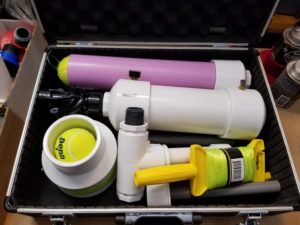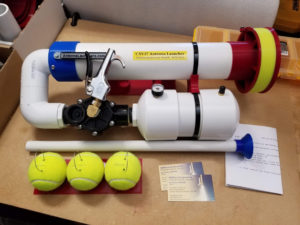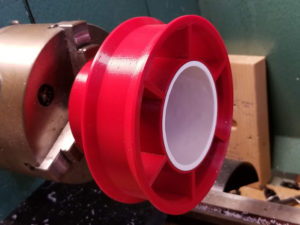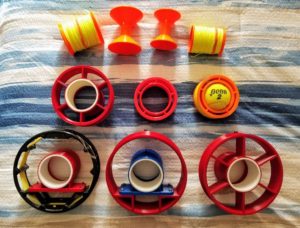What is an Antenna Launcher?
An Antenna Launcher is a line launching system designed and optimized for placing antenna support lines as well as lines for other applications. Compressed air or CO2 is used to propel a safe projectile towing a lightweight line over or across an obstacle like a tree, brush, structure, tank, aqueduct or expanse of water or inside a building where access is limited and this light line is then used to pull (stage) heavier lines as needed to support antennas, safety and fall protection lines, pull cables or wires, etc. These are used not only for antenna work but also for roof work, tree canopy work and electrical work to get a line into places that may be difficult otherwise.
I designed these Pneumatic Launchers and named them “Antenna Launchers” in about 2003 as it was the best description I could find for their function. Others have since used the term for other types of devices like slingshots, but this is the home of the Original Antenna Launchers. (Alan, w6akb)
If you want to learn more about the development of Antenna Launching and Pneumatic Antenna Launchers, please visit our Antenna Launching pages. If you are interested in our available Launchers, read on.
Which Launcher is Best for Your Application?
Values shown are typical, not guaranteed. Actual results are dependent on many variables including wind, altitude, variation in components and other factors beyond our control.
The first question to answer is how high are your trees (or other line installation targets)? If they are just over 100 feet or less, then the CSV17 or PADS setups are recommended. These smaller launchers are more portable and convenient to use. For trees well over 100 feet the larger CSV19 is indicated. For special applications the CSV23 may be required. The horizontal distance the launches can cover is about 2 or more times the vertical height. The more the horizontal distance is needed the lower the launch height.
We offer several sizes of launcher to meet different performance requirements. The CSV19 is about 19 inches in length, uses 4″ diameter pipe in the chamber and is designed to fit in a 10 gallon Rubbermaid(tm) tote. It can typically reach more than 160 feet in height in good conditions (height depends on conditions that do vary). The smaller CSV17 (example shown above) is about 17 inches long, and uses 3″ diameter pipe in the pressure chamber. It is designed to be very portable and fit in an 18 inch tool case. The CSV17 reaches typically more than 120 feet in height. The CSV17 is a bit more ‘efficient’ and will make a good launch on a single 12 or 16 gram CO2 charge (use a bicycle tire filler adapter). The CSV19 is a larger launcher with greater capability to but it weighs more and requires more air volume. For those with special requirements we have made the custom special order magnum CSV23 that has four more inches of barrel and chamber length, and will reach out higher and farther. It is difficult to get beyond about 200 feet of height, even with higher power while using a safe projectile.
Launchers are available in several configurations:
- Basic Kit (just the minimum for the launcher itself)
- Super Kit (with more stuff and fishing reel mount)
- Super-MCR Kit (with more stuff and Coaxial Reel)
- Deluxe PADS Kit (with case, Reel and accessories)
- Semi-Assembled versions of the Super and PADS models
- Pre-Assembled versions of the Super and PADS models
The Basic Kits include the parts for the launcher. This includes the special and hard to find SDR21 barrel material (which we use on all our launchers) and the precision machined parts, the pressure gauge, the fill valve, the trigger and the modified main valve. The full parts list detail is on the ordering web pages. You will need PVC Primer and Cement (or a single-step cement), and a few tools to assemble the launcher as listed below. You will also need to prepare Tennis Balls, and you will need some accessories to Launch for Antennas.
The Super Kits go one step further. They include the Basic parts for the launcher, plus a launch ball loop kit for six tennis balls including a safety ball holder, sand measure and special funnel, a ramrod with ball pusher, a pressure safety relief valve, a tap for the holes, and either a reel mount for a fishing reel (fishing reel not supplied) or the Mini Coaxial Reel with the special High Visibility 50 pound test prime quality Spectra type Launching Line, depending on the kit model (MCR reels in MCR sets only).
The deluxe PADS (Pneumatic Antenna Deployment System, shown at the top of this page with optional accessories) goes one step further (beyond the Super Kits) and includes a special Mini-Coaxial reel with Spectra-type Launch Line, a plastic reel of nylon twine and a Hard Case for the CSV17 launcher and accessories. The PADS is available in Kit, Semi-Assembled and Pre-Assembled variations.
The PADS Gold is a limited edition deluxe package with extra features and accessories, which changes periodically. It is available in pre-assembled form. Find details about it in the online catalog linked below.
 The Linear Pneumatic Antenna Launcher is a Limited Special Edition take-down Linear configuration Antenna Launcher. It is based on the PADS CSV17 components, but the linear configuration allows a longer pressure chamber and barrel for increased performance while disassembly is required but allows it to fit in the same 18″ tool case. Find the full details on the LPAL page linked below.
The Linear Pneumatic Antenna Launcher is a Limited Special Edition take-down Linear configuration Antenna Launcher. It is based on the PADS CSV17 components, but the linear configuration allows a longer pressure chamber and barrel for increased performance while disassembly is required but allows it to fit in the same 18″ tool case. Find the full details on the LPAL page linked below.
Recommended Tools for Assembly
To build a Kit you need (some kits include some of this):
- PVC primer and cement (or the preferred one step PVC cement)
- Q tips and paper towels
- newspapers
- 1/8 NPT tap, drill and bit
- brillo type scrubbing pad and running water
- fine sandpaper or sanding block
- pencil and tape measure
- a few index cards and scotch tape
- masking tape
- wrenches
- tennis balls
- utility knife
- leather sewing needle or small drill bit
- clean dry sand
- postal scale (to weigh 2 ounces) (or sand scoop)
- hot melt glue gun and glue
- source of air pressure
- ability to follow instructions
- a place to work that is not too cold and has good ventilation, away from small children
- a little patience
The Semi-Assembled Versions of our Super or PADS models are much easier to assemble than the kits above. The pressure chamber has been cleaned, dried, cemented, drilled, tapped and vacuumed. The U has been cemented. So there is no PVC cementing to do, no PVC primer or cement required, and the chamber has already been drilled and tapped. The rest of the assembly steps remain. These also include 3 ready to go launch balls but do not include the tap, loop kit or safety ball holding tool that are in some of the kit versions. At this time there are no separate instructions, use the regular assembly instructions and skip the parts we have already done for you.
The Pre-Assembled Version can be selected on the Super or PADS models, and we will build the launcher for you. This takes a bit longer, of course. These come with 3 ready to go launch balls but do not include the tap, loop kit or safety ball holding tool. Add air and launch!
Selecting a Reel
You could just lay the line on the ground, and some do, but it is much more convenient to use a reel. If you already have a moderate size spinning reel (or closed face spin-cast reel) they work. They can be mounted on a PVC slip-collar with some hose clamps, such as provided in the Super Kit (this is called the Fishing Reel Mount). You can even hose-clamp a fishing reel directly on the barrel of a launcher, though it is a bit less convenient to hold the whole launcher when retrieving the line instead of removing the coupler and holding only the reel and coupler. Instead of a fishing reel you can mount a medium size spool of monofilament on the coupler using an L bracket from the hardware store, a long bolt, some washers and a hose clamp for a budget reel. It is a bit more effort to wind up, but it works!

The largest and best reel we found was the Zip Reel from Saunders Archery with a custom machined mounting system developed by Eric WD6CMU. This reel is nearly 2 feet in circumference and feeds line with minimum drag, producing the greatest height launches. The Zip reel can hold a great deal more line if you are very careful to avoid tensioning it on the spool. It is not designed to have any tension on the line in the spool. Saunders Archery no longer makes the Zip Reel component that Eric used to make these, we have since moved on to the Mini Coaxial Reel (and others) shown below. If you have a Zip reel take good care of it. Even moderate tension on the line can break the spokes. We do have a newly designed replacement spool that mounts to Eric’s Zip Reel Core, as well as replacement Zip Cores for those with damaged Zip Reel systems. See the Online Catalog linked below for details.
The Mini-Coaxial reel is provided in the PADS and other “M” packages and is available separately as an accessory. This is essentially a slightly smaller variant of the Zip Reel designed to fit in the space available in the 18″ Tool Case we use for the PADS Antenna Launchers. Even with the slight reduction in size it performs well and feeds about 15 inches of line per turn while fitting into the 18 inch case for better portability. This reel comes preloaded with 125 yards of Spectra Launch Line. It works with all launchers that have a 2 1/2″ PVC barrel (all of ours), and replaces the no longer available ZIP reel. The older white PVC version of the Mini Coaxial Reel is shown in the photo at the top of this article. The current version of the Mini Coaxial reel is 3D printed (shown here in Red), includes two inches of barrel extension inside, and can hold up to 250 yards of our launch line. We also have smaller and larger versions of this reel in the online catalog. Here are some of the Reels and Spools we have available:
Top row are Drill Twine Spools Large and Small (for second stage twine lines). Middle row from left is Mini Coaxial and a couple of Micro Coaxial backup reels. Bottom row left to right is Saunders Zip Reel with Replacement Core, Zip Replacement Spool with Replacement Core and Maxi Reel. The Zip Replacement Spools and Maxi Reels will fit into a Harbor Freight 11″ case (the real Zip is a bit too large). Zip is a trademark of Saunders Archery.
More Information and Ordering
For more information please visit:
- CSV17 Launcher Page
- CSV19 Launcher Page
- PADS Launcher Page
- LPAL Linear 17 inch Launcher Page
- Parts and Accessories Page
- Launcher User Manual
For Ordering visit the Online Catalog:
NOTE – details subject to change without notice. These launchers are built from available parts and materials and availability controls what we can use (and it changes slightly with time, supplier, etc).
Alan, w6akb


